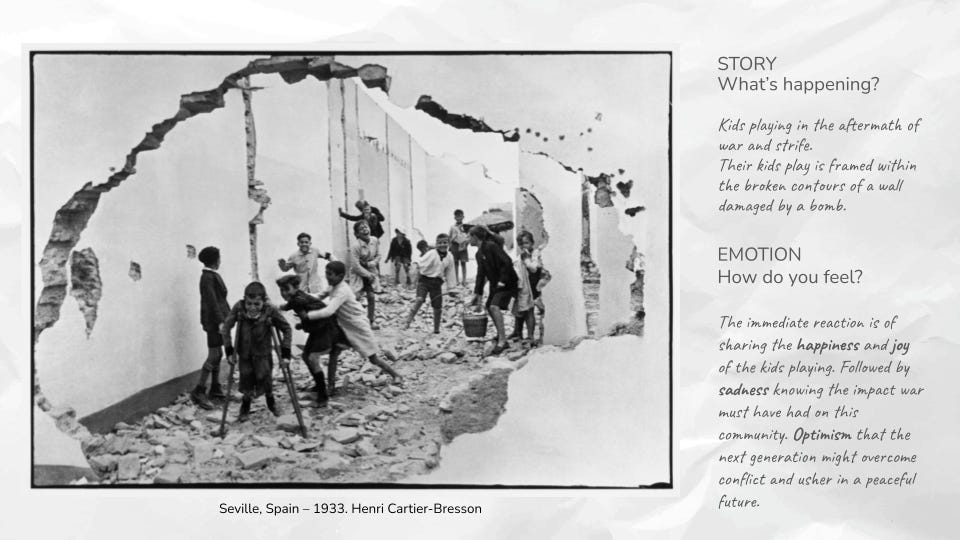How to tell a good photo from a crap one
A simple 2-step formula to analyze images and refine your taste in photography
When I was a high schooler growing up in Mumbai, I developed an interest in photography, even though I didn’t have a camera. This was the era of film photography, before cell phones, and before DSLRs. I started visiting a nearby bookshop with an unusual collection of international magazines and publications, including books on photography. About three or four times a week I would visit the store, browse through some photography books and leave. After a few weeks, I was pulled up by the store attendant - "Hey, you know this is not a library. Do you want to buy something?". That was my last visit to that shop. However, it had already triggered a desire to appreciate "good" photography.
Why develop good taste?
In a world of disappearing pictures, powerful cameras in budget phones that compete with SLRs, and the zero cost of clicking, storing, and sharing photos -- does photography as a craft matter anymore? Must we learn how to identify a good photograph? Would it enhance our lives if we were able to recognize a good image?
I would argue an emphatic yes! A refined taste helps us appreciate the good things in life, whether it is pictures, movies, music, or sports. It is also the stepping stone to becoming better at the craft itself. If you can recognize good pictures, you have the foundational knowledge to take good pictures.
Legendary music producer Rick Rubin - who has worked with some of the most successful recording artists of our times including Jay-Z, Eminem, Beastie Boys, Tom Petty, and Adele - said something remarkable in a recent interview with Anderson Cooper.
Anderson: Do you play instruments?
Rick: Barely
Anderson: Do you know how to work a soundboard?
Rick: No, I have no technical ability. And I know nothing about music.
Anderson (laughs): But you must know something?
Rick: Well, I know what I like and what I don't like. And I am decisive about what I like and what I don't like.
Anderson: So what are you being paid for?
Rick: The confidence that I have in my taste, and my ability to express what I feel has proven helpful for artists.
By the time you finish today's post, you will have the necessary tools to analyze pictures that contain human beings (or at minimum living beings) and be able to recognize good ones from the trash. We will not get into the technical aspects of aperture, shutter speed, golden ratio, or the perfect gear. We will assume zero photography skills, and stick to what the picture reveals to us, what it can communicate.
The Simple Formula For Analyzing Photographs
Here is a simple two-step formula to assess a photo - ask yourself two questions:
Question 1
"What's happening?" - The Story
Without any more input, does the picture prompt you to conjure up a story in your mind about the scene it captures? What happened before the picture was clicked? What might happen a moment later? What is this moment about? What is the story behind this image?
Question 2
"How do you feel?" - The Emotion
As you look at this picture, what emotions does it evoke (if any)? Do you feel sadness, nostalgia, joy, or anger? Or even better, does it create a mixture of conflicting feelings, perhaps feelings that are difficult to express? What is the emotion behind this image?
Let me demonstrate this technique through a quick analysis of three of Henri Cartier-Bresson's iconic photographs.
(This post is better viewed on a desktop so you can see these images clearly)
So now, what makes a photo "good"?
Based on the two-step formula for analyzing a photo, here are the main criteria for recognizing a good picture from a bad one:
A good photo will stimulate you to respond to both the questions - "What's happening?" and "How do you feel?" - if you get stuck on either the story or the emotion, it is not a successful photo.
If you are enjoying doing the two-step analysis, it’s a good photo. And the more time you spend with a good image, the more it will reveal to you, the more you will appreciate it.
The more complicated the story or the emotions it provokes in you, the better the image.
Homework Assignment
Now that you understand the two-step formula for analyzing photographs (with humans) and you understand the criteria to identify good photos from bad ones, perform the analysis for the following three images (also by Henri Cartier-Bresson). You may share your answers in a comment below, and see if it matches up with other readers.
Hope you enjoyed today's post. Please share it with one other person who might be interested in developing a creative mindset.
Cheers,
Rakesh
Tool Shed
You probably have a DSLR camera that is catching dust and spider webs on some corner shelf. If yes, then I recommend getting a prime 50 mm lens and using it exclusively to shoot your next family event.
Example: Canon EF 50mm
A prime lens has no zoom, and it forces you to move your body physically to frame the shot. It makes you think for an extra few seconds before you click. Those few extra seconds will add up to make you a vastly better photographer over a short period.
Around the Corner
The best way to develop good taste in something is to expose yourself to the works of masters. Here are some sites that provide curated works of master photographers:
https://www.magnumphotos.com/
https://www.nationalgeographic.com/photography/
https://aperture.org/








